Lamanai Belize Ruins: The Mayan Mask Temple
The Lamanai ruins in Belize are some of the most fascinating Mayan ruins in Central America, complete with a ‘Mask Temple’ that has giant stone faces carved into the foundation. It looks like something from Indiana Jones!
Lamanai means ‘submerged crocodile’ and this area on the riverside was settled by the Mayans for thousands of years. Excavation was only started in the 1970s, and it continues today.
You can visit Lamanai pretty easily on a day trip from places like Orange Walk, Belize City, or even San Pedro in Ambergris Caye. Along the way, you get to enjoy a river boat ride through the jungle, with the sounds of tropical birds and howler monkeys in the tree tops.
This travel guide will explain how to get to Lamanai Belize, what to see at the Mayan ruins, best tour packages to use, and everything else you need to know before you go!
Best Lamanai Tours
One of the best ways to visit Lamanai is with a day tour package.
If you’re coming from Belize City or the cruise port, Viator has a high-rated Lamanai tour with a river boat cruise, wildlife watching, and all of the best Mayan temples of the area.
The price includes a local Belizean guide and driver, lunch, park fees, and pickup and drop-off from Belize City hotels, the cruise port, or the airport.
We’ve used Viator for lots of tours and activities around the world, and they’re great. Highly recommended!
Where Is Lamanai Located? How To Get There
Lamanai is located in northern Belize, near the New River, and you can get there by either car or boat.
The closest significant town is Orange Walk, but you can also visit Lamanai on a day trip from anywhere in northern Belize, including Belize City, Ladyville, Los Lagos, Caye Caulker, or San Pedro in Ambergris Caye.
If you’re driving to Lamanai with a car, it’s about 1 hour from Orange Walk town, or more than 2 hours from Belize City. The distance is actually not very far, but the roads near Lamanai are dirt and gravel, and they’re not in great condition. Four-wheel drive is recommended, especially in the rainy season.
Lamanai tours normally go to the archaeological site by boat instead of car. This is the most fun and interesting way to do it, because you get to relax and enjoy the river views, while also watching for birds and other wildlife.
The boat ride to Lamanai takes about 1 hour, and it’s one of the great things about coming here, in my opinion!
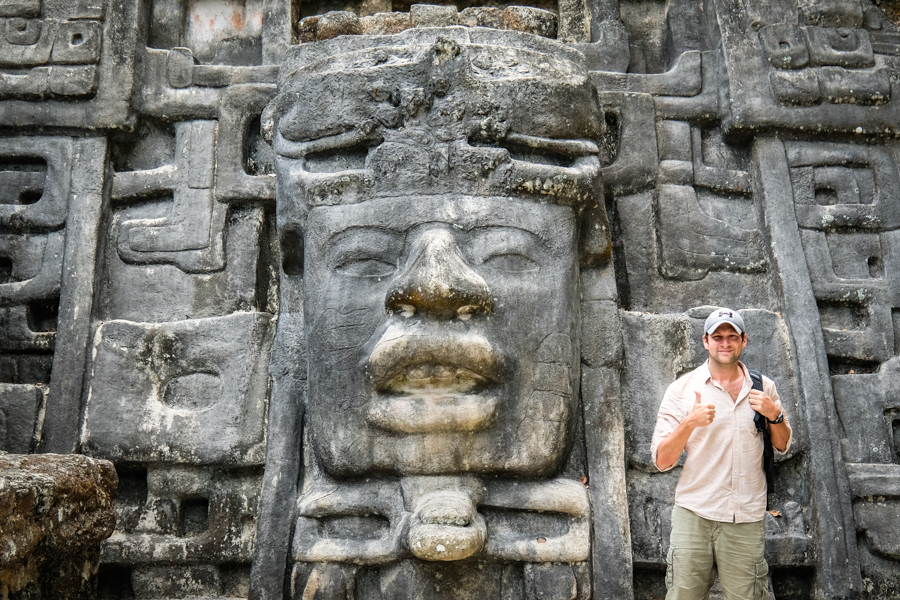
Lamanai Ruins: What To Expect
There are 5 main temples at Lamanai, with a bit of walking between each one. It also has a small museum with some Mayan artifacts, and a 19th century sugar mill that was swallowed up by a strangler fig tree after being abandoned.
Most Lamanai tours will start with the Jaguar Temple and then go to the Royal Complex, Ball Court, and High Temple, before ending at the Mask Temple and then heading back to the visitor center.
In total, you’ll walk about 1.5 kilometers (1 mile) throughout the day, although it’s spread out over the course of about 2 hours, so it doesn’t feel like too much at all. Most of the walking is flat and easy, but if you choose to climb the temples then that can be a bit more strenuous.
There is plenty of wildlife to be seen at Lamanai Archaeological Reserve — bats, howler monkeys, spider monkeys, crocodiles, iguanas, tarantulas, exotic birds, and many other kinds of animals call this place their home. You might even see a jaguar if you’re lucky.
You’ll hear the howler monkeys before you see them. They’re very loud! We encountered a bunch of them in the treetops near the first temple, and at first their roaring sounded like something much bigger and more dangerous, but they’re actually harmless monkeys.
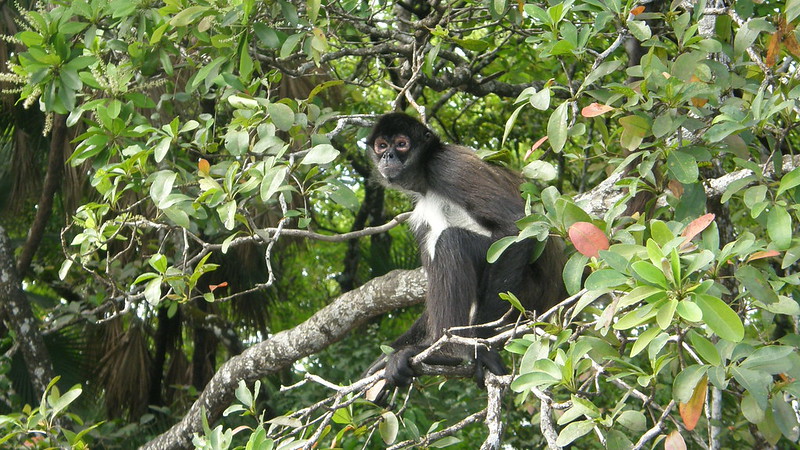
• Jaguar Temple
The Jaguar Temple is generally the first temple you’ll pass on a tour of the Lamanai Mayan ruins.
It’s a pyramid-shaped temple with 7 levels and a height of almost 30 meters (100 ft), making it the second tallest at Lamanai. In fact, the base of the temple is still partly underground, but if it was fully excavated it would actually be the tallest building at Lamanai.
Some tours climb the Jaguar Temple, although ours did not. It gets its name from two blocky stone masks carved into the front of the temple that are meant to represent jaguars, although I thought they looked more like crocodile faces myself.
Archaeologists have discovered some hidden caches in this temple containing jade masks and other Mayan artifacts. Very interesting!
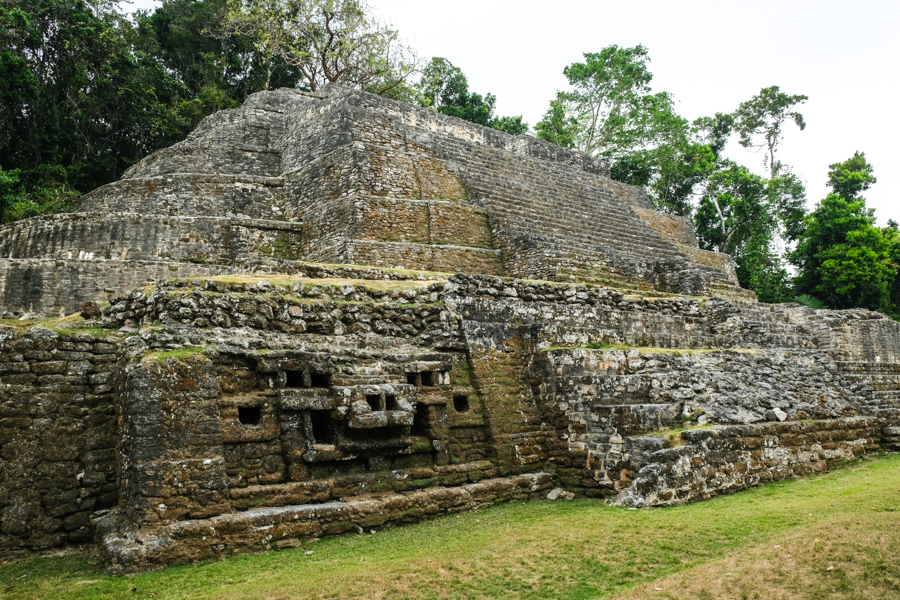
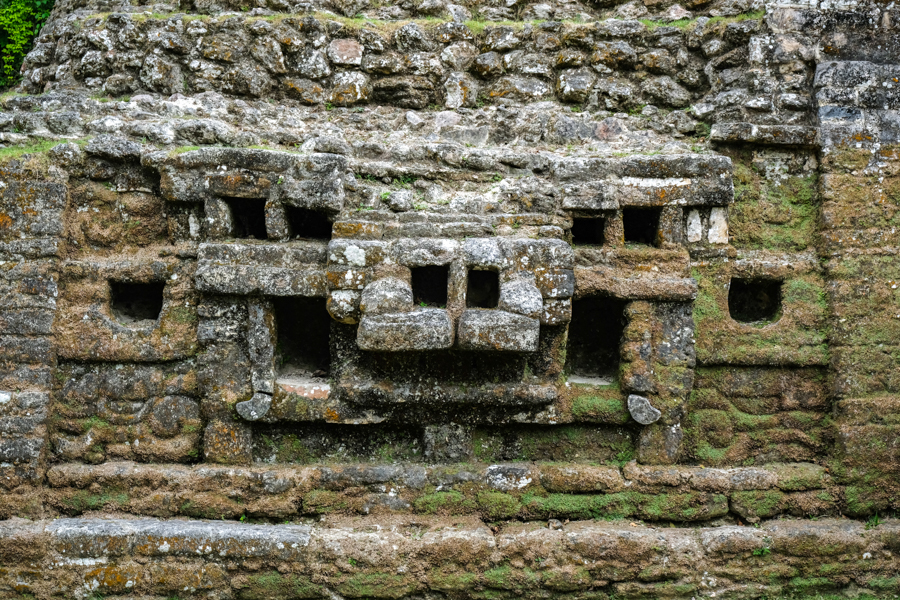
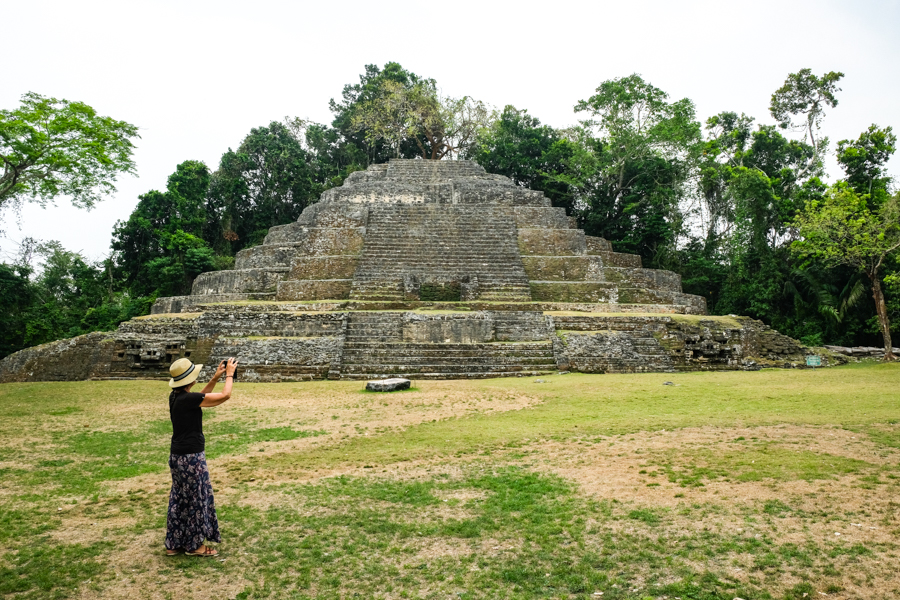
• High Temple
The High Temple is the tallest monument at Lamanai, and at the time it was built, it was most likely the tallest building of the Mayan world!
It has a height of 33 meters (108 ft), making it about as tall as a modern 10-story building. Impressive. It’s still one of the biggest Mayan structures in Central America.
You can usually climb to the top of the High Temple, although it was closed for restoration work when I was there. The top has amazing panoramic views of the jungle canopy!
It’s a tough climb so be careful and take it slow. Some of the steps are awkward and uneven.
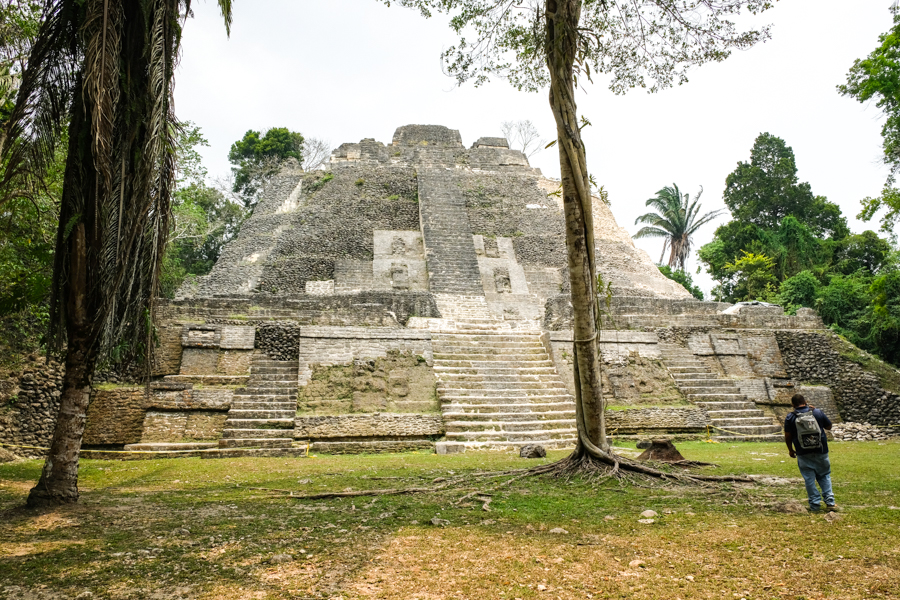
• Mask Temple
Last, but not least, there’s the Mask Temple of Lamanai, which was my favorite part of the whole place, although it’s one of the smaller temples of the bunch.
This is another temple that you can climb for the views on top, but the most unique thing about the Mask Temple would have to be the giant stone faces carved into the foundation, which is how it gets its name.
The masks are almost 4 meters tall and they’re meant to represent an ancient Maya king wearing a crocodile headdress. I love this kind of stuff! There are two masks, with one on each side of the temple’s front.
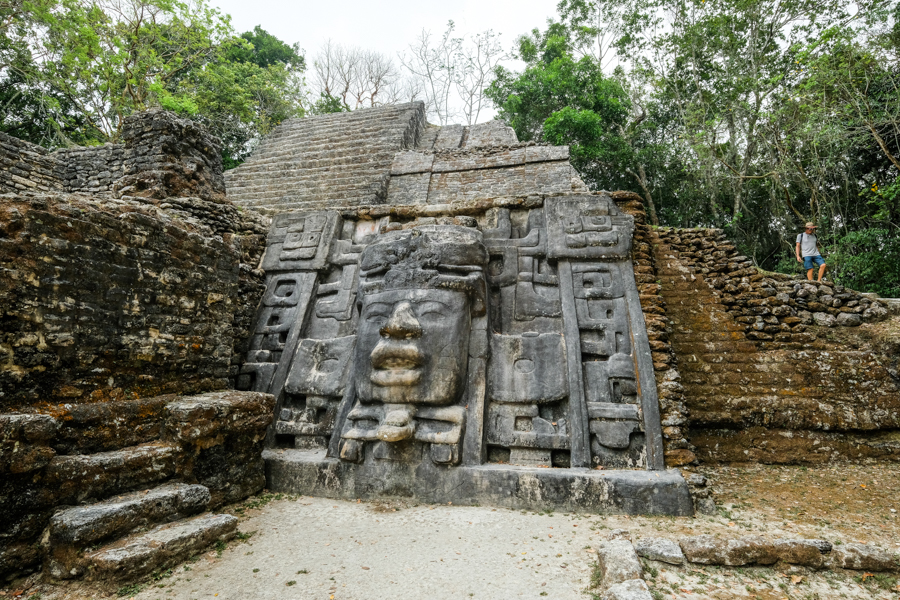
According to archaeologists, the stone faces at the Lamanai Mask Temple were added by the Mayans sometime around 400 AD, which is almost 600 years after the rest of the temple was built.
A tomb was found inside the temple that held the remains of a man, with jade and shell artifacts. A second tomb for a woman was also found nearby.
These may have been former rulers at Lamanai, but no one knows for sure.
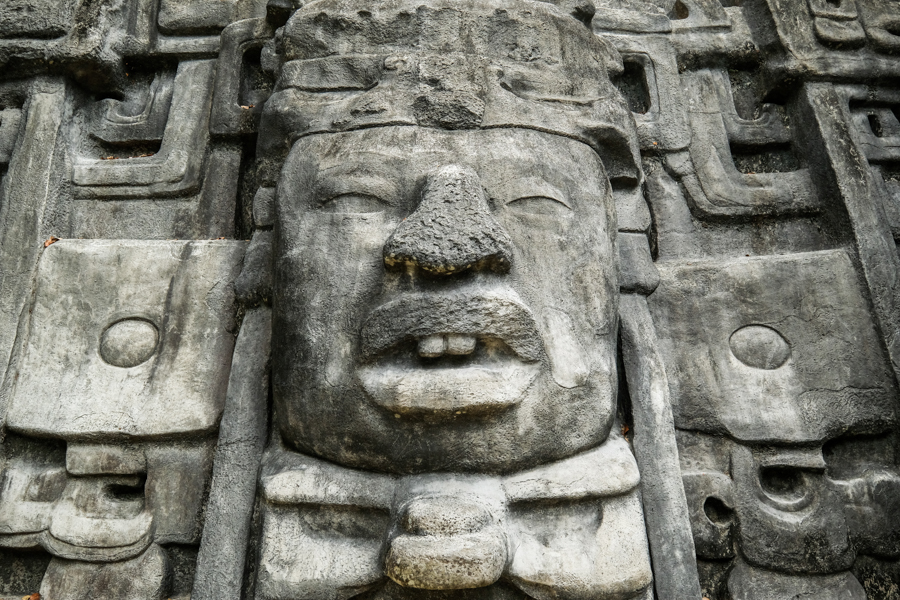
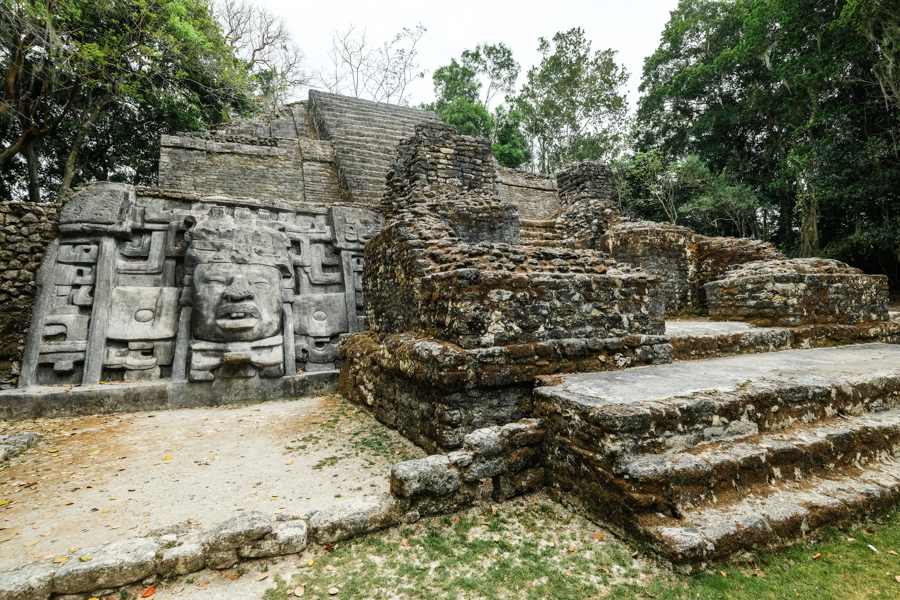
• Entrance Fees*
- Foreigners: $10 BZD ($5 USD)
- Locals: $5 BZD
*Lamanai tours usually include the park fee in the total price, so it’s already taken care of. Otherwise, you can pay it when you get to the visitor center.
• Opening Hours
- 8 AM – 5 PM
The Mayan ruins are open seven days a week, every day of the year, from 8 AM to 5 PM.
Best Time To Visit The Lamanai Ruins
The best time of day to visit the Lamanai ruins is in the morning, that way you can avoid the worst heat. Tours normally start with an 8 AM pickup, which should put you at the ruins by about 10 AM.
You can visit Lamanai at any time of year, but generally the best time to visit is during the dry season in Belize, which runs from December to May. The months of February, March, April, and May are especially dry and sunny in Belize, so you aren’t likely to run into a rainy day at this time of year.
During the wet season it’s still possible to visit Lamanai, but you’re more likely to encounter rain. The wet season runs from June to November in Belize.
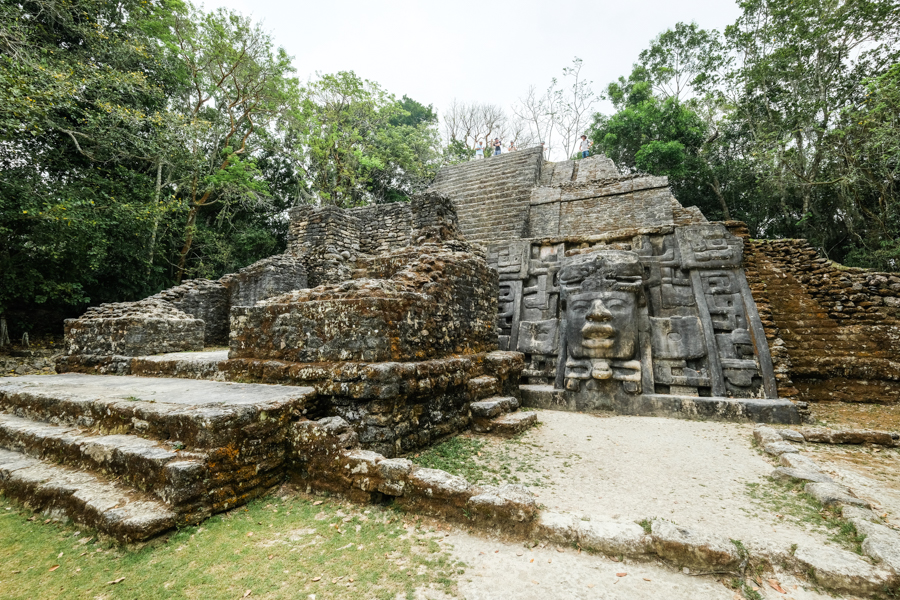

Is Lamanai Safe?
Yes, Lamanai is pretty safe. Even though the country of Belize doesn’t have a perfect safety record, I’m not aware of any crimes or violent incidents against tourists in the Lamanai area.
I carried my Fuji camera and took lots of pictures at the Mayan ruins, but I kept it hidden discreetly in my bag when I was walking around at the visitor center and other public areas where I didn’t need to use my camera.
If you want some extra peace of mind, you could also bring a hidden travel belt (like this one on Amazon) and put some of your valuables in it. That’s what I did with my phone, cash, and credit cards on my first visit to Belize.
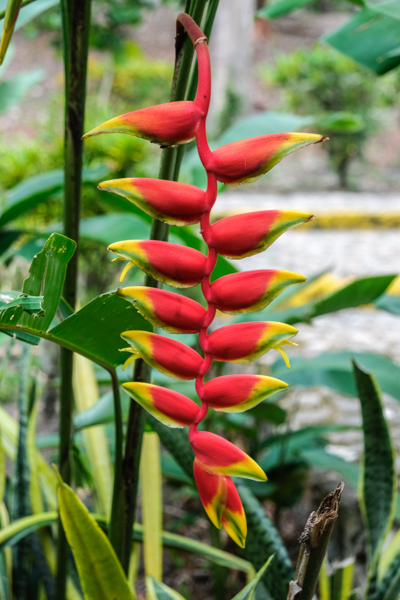

Other Tips For Lamanai Belize
- Where To Stay: If you want to stay near the Lamanai Mayan ruins, there are a few small guest houses in the town of Indian Church, such as the Lamanai Outpost Lodge. You can also find plenty of comfortable hotels in Orange Walk town.
- What To Wear: Dress for the tropics! Temperatures can be hot and humid here in the daytime, so you’ll want to have lightweight summer clothing. I wore shorts and flip flops. Shoes are not required for climbing the temples, but can be helpful. Just remember to dress modestly since Lamanai is an important place for the locals.
- Bug Spray: I didn’t notice any bugs or mosquitoes at Lamanai during the dry season, but it’s still a good idea to apply bug spray just in case. This is especially true if you visit in the wet season, when you’re likely to see more bugs. There may be some risk of Dengue or Chikungunya from mosquitoes, but Malaria is not an issue at the Lamanai Archaeological Reserve. I would not take anti-malarials.
- Bathrooms: There are clean public toilets at the entrance to the park, near the visitor center, right after you get off the boat at Lamanai. You won’t find any bathrooms later on at the ruins themselves, so this is the best place to take care of business before and after seeing the ruins.
- Snacks & Drinks: There are small shops at the park entrance where you can buy snacks, drinks, or souvenirs from the Lamanai Archaeological Reserve.
- Cell Service: There is some cell service at the Lamanai park if you need to make a phone call or send a text message.
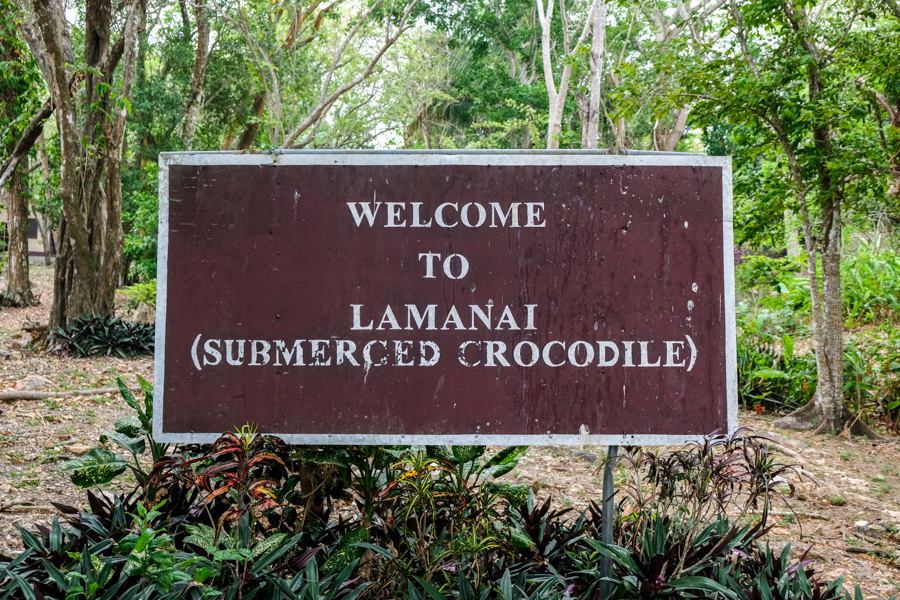
Is Lamanai Worth It?
Yes, in my opinion Lamanai is totally worth visiting, whether you’re a cruise passenger or just happen to be traveling in Belize or a neighboring country!
I think these are some of the most unique and interesting Mayan ruins in Central America. The history, architecture, and wildlife are all fantastic.
Lamanai is well preserved and it feels like a movie set. All of this is why I’d rate it as a bucket list activity.
More Central America Travel Tips
Thanks for looking! I hope you enjoyed this travel guide for the Mayan ruins of Lamanai in Belize.
Don’t forget to check out my other travel blog posts for Central America and South America before you go!
Happy travels!


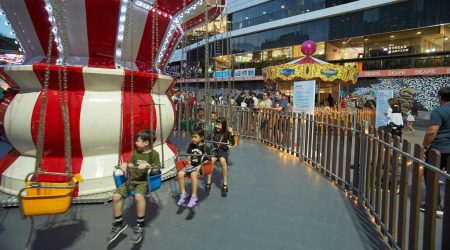
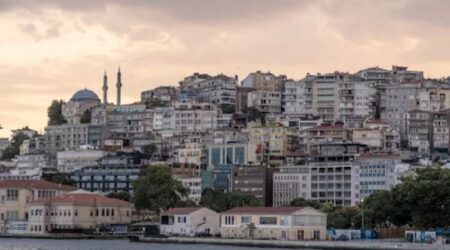


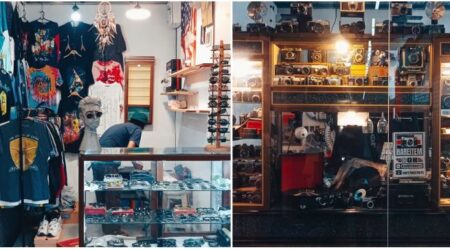
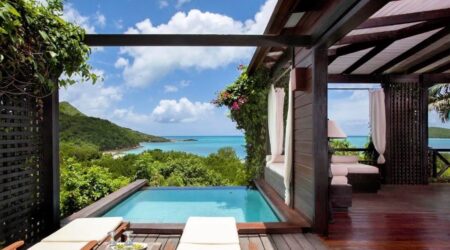
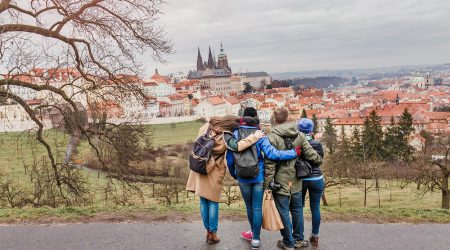

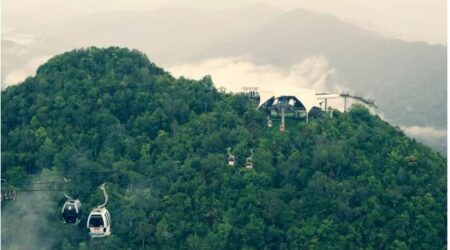
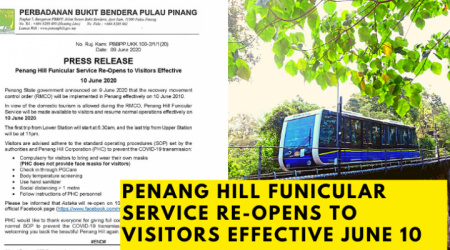
Leave a Reply